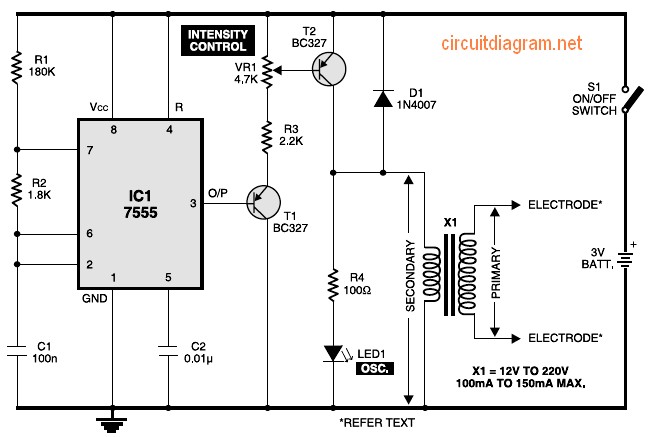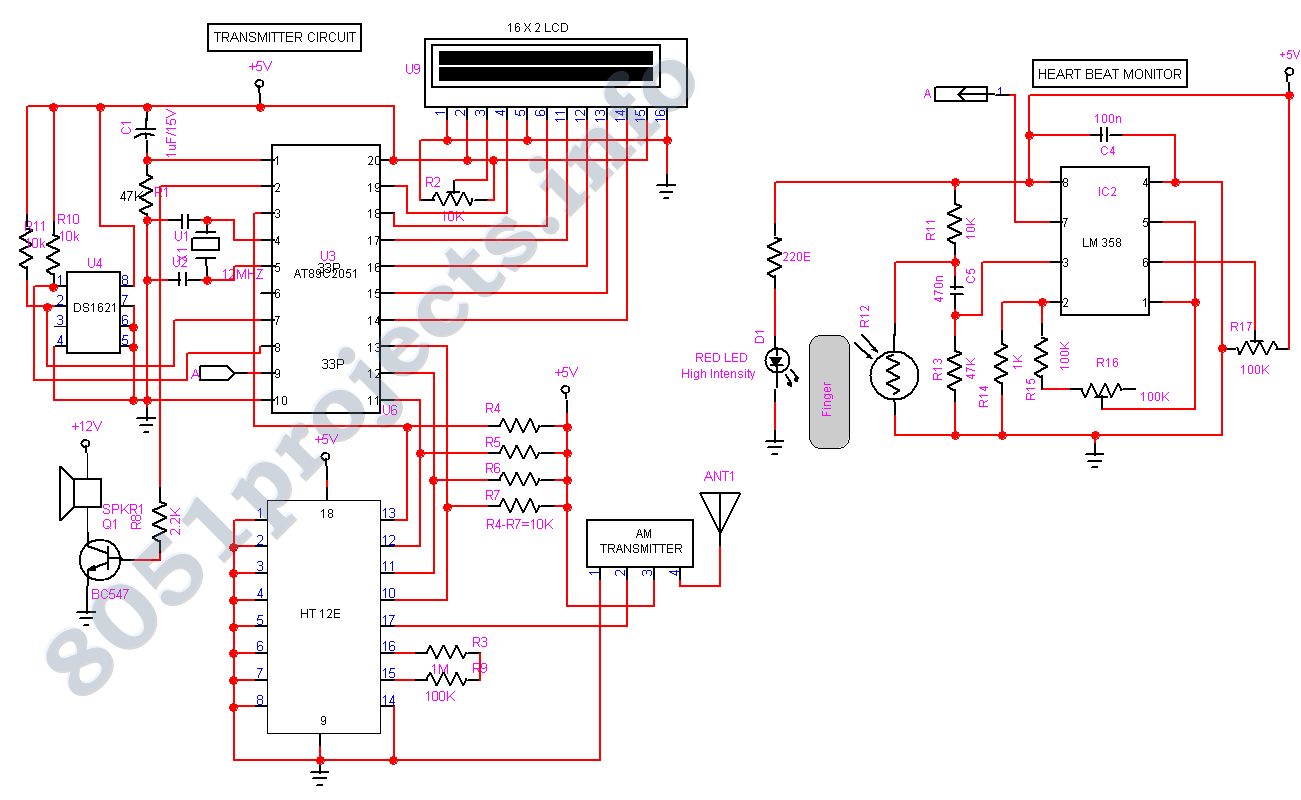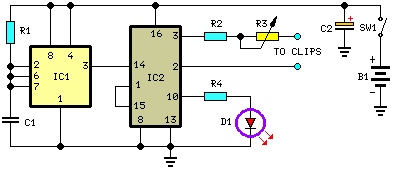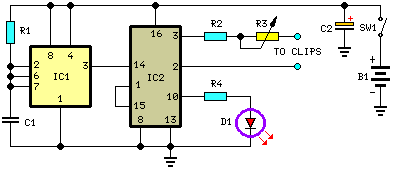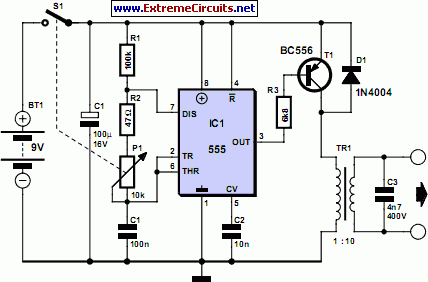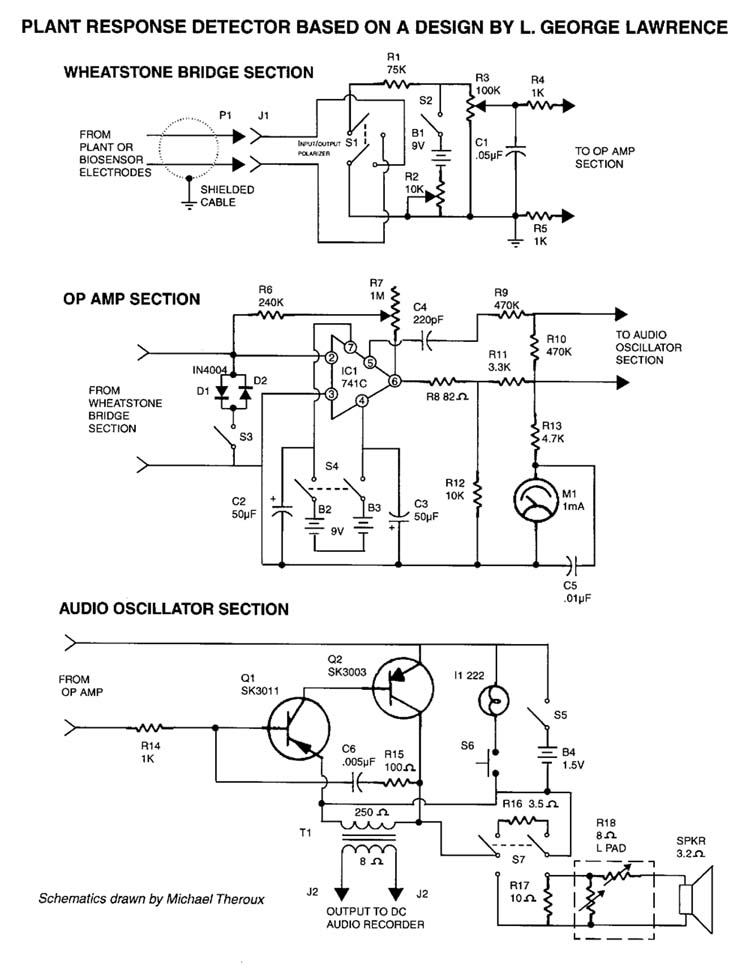
Muscular Bio stimulator
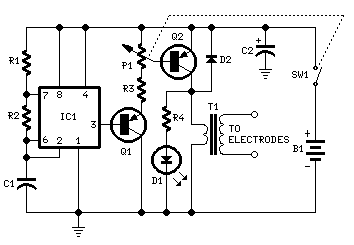
SW1 should be connected to P1 to prevent sudden voltage spikes on the patient's body during switch-on. However, a standalone SPST switch can also be effective, as long as the P1 knob is set fully counter-clockwise upon activation. Some commercial devices feature four, six, or eight output electrodes. To achieve this, the circuit section consisting of IC1, R1, R2, C1, C2, SW1, and B1 can be retained. Other components in the schematic, such as P1, R3, R4, D1, D2, Q2, and T1, can be replicated in multiples of two, three, or four. Additional potentiometers and R3 series resistors should be connected in parallel and linked from the emitter of Q1 to the positive supply. Commercial devices often include a built-in 30-minute timer. For this purpose, the Timed Beeper, Bedside Lamp Timer, or Jogging Timer circuits available on this website can be utilized, with timing components adjusted to meet specific requirements.
The circuit design described involves a key switch (SW1) that is crucial for managing voltage levels to ensure patient safety during operation. By connecting SW1 to potentiometer P1, the circuit minimizes the risk of voltage peaks, which can be harmful. The alternative use of a standalone single-pole single-throw (SPST) switch is permissible, provided that the operator is diligent in setting P1 to its minimum position before powering the device.
In configurations with multiple output electrodes, the retention of the specified circuit components (IC1, R1, R2, C1, C2, SW1, and B1) is essential for maintaining functionality. The flexibility to duplicate other components such as P1, R3, R4, D1, D2, Q2, and T1 allows for scalability in device design, accommodating varying numbers of electrodes based on the application requirements.
The additional potentiometers and series resistors (R3) must be arranged in parallel to ensure that the circuit maintains consistent performance across all outputs. These components should be connected from the emitter of transistor Q1 to the positive power supply, ensuring that the circuit operates within the desired voltage range.
For applications requiring timed operation, the integration of a timing mechanism is advisable. The available circuits, such as the Timed Beeper, Bedside Lamp Timer, or Jogging Timer, can be adapted for use in this design. Adjustments to the timing components will be necessary to align with the operational needs of the specific application, ensuring that the timing function is both effective and reliable.SW1 should be ganged to P1 to avoid abrupt voltage peaks on the "patient`s" body at switch-on, but a stand alone SPST switch works quite well, provided you remember to set P1 knob fully counter-clockwise at switch-on. Some commercial sets have four, six or eight output electrodes. To obtain this you can retain the part of the circuit comprising IC1, R1, R2, C1, C2, SW1 and B1. Other parts in the diagram (i. e. P1, R3, R4, D1, D2, Q2 & T1) can be doubled, trebled or quadrupled. Added potentiometers and R3 series resistors must be wired in parallel and all connected from Emitter of Q1 to positive supply. Commercial sets have frequently a built-in 30 minutes timer. For this purpose you can use the Timed Beeper the Bedside Lamp Timer or the Jogging Timer circuits available in this Website, adjusting the timing components to suit your needs
🔗 External reference
The circuit design described involves a key switch (SW1) that is crucial for managing voltage levels to ensure patient safety during operation. By connecting SW1 to potentiometer P1, the circuit minimizes the risk of voltage peaks, which can be harmful. The alternative use of a standalone single-pole single-throw (SPST) switch is permissible, provided that the operator is diligent in setting P1 to its minimum position before powering the device.
In configurations with multiple output electrodes, the retention of the specified circuit components (IC1, R1, R2, C1, C2, SW1, and B1) is essential for maintaining functionality. The flexibility to duplicate other components such as P1, R3, R4, D1, D2, Q2, and T1 allows for scalability in device design, accommodating varying numbers of electrodes based on the application requirements.
The additional potentiometers and series resistors (R3) must be arranged in parallel to ensure that the circuit maintains consistent performance across all outputs. These components should be connected from the emitter of transistor Q1 to the positive power supply, ensuring that the circuit operates within the desired voltage range.
For applications requiring timed operation, the integration of a timing mechanism is advisable. The available circuits, such as the Timed Beeper, Bedside Lamp Timer, or Jogging Timer, can be adapted for use in this design. Adjustments to the timing components will be necessary to align with the operational needs of the specific application, ensuring that the timing function is both effective and reliable.SW1 should be ganged to P1 to avoid abrupt voltage peaks on the "patient`s" body at switch-on, but a stand alone SPST switch works quite well, provided you remember to set P1 knob fully counter-clockwise at switch-on. Some commercial sets have four, six or eight output electrodes. To obtain this you can retain the part of the circuit comprising IC1, R1, R2, C1, C2, SW1 and B1. Other parts in the diagram (i. e. P1, R3, R4, D1, D2, Q2 & T1) can be doubled, trebled or quadrupled. Added potentiometers and R3 series resistors must be wired in parallel and all connected from Emitter of Q1 to positive supply. Commercial sets have frequently a built-in 30 minutes timer. For this purpose you can use the Timed Beeper the Bedside Lamp Timer or the Jogging Timer circuits available in this Website, adjusting the timing components to suit your needs
🔗 External reference
Warning: include(partials/cookie-banner.php): Failed to open stream: Permission denied in /var/www/html/nextgr/view-circuit.php on line 713
Warning: include(): Failed opening 'partials/cookie-banner.php' for inclusion (include_path='.:/usr/share/php') in /var/www/html/nextgr/view-circuit.php on line 713
